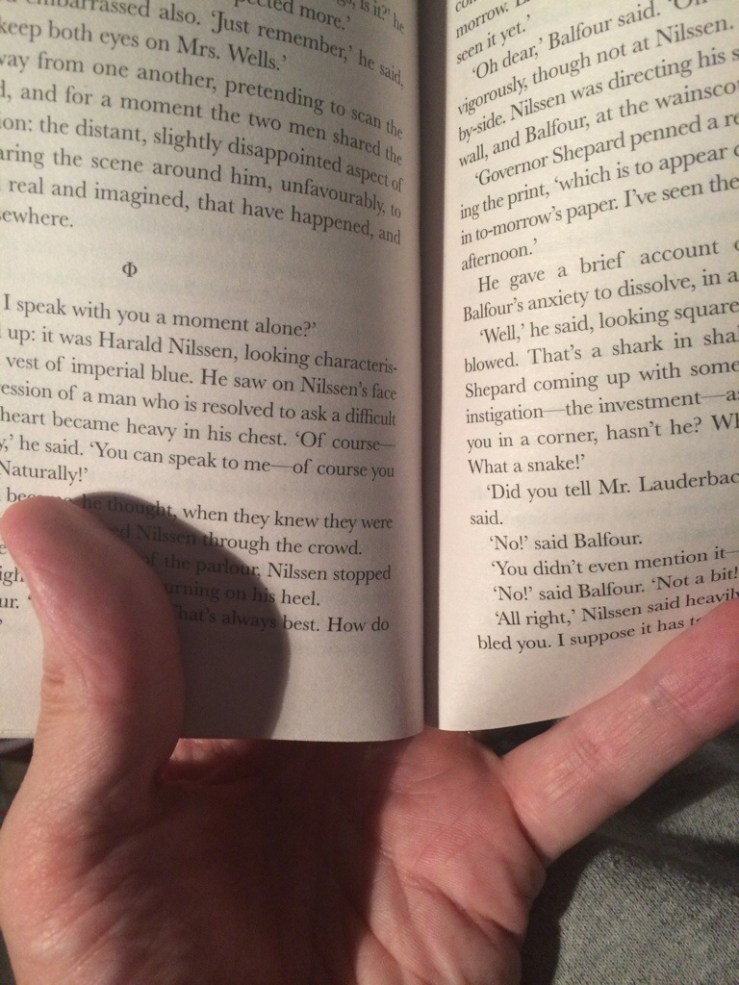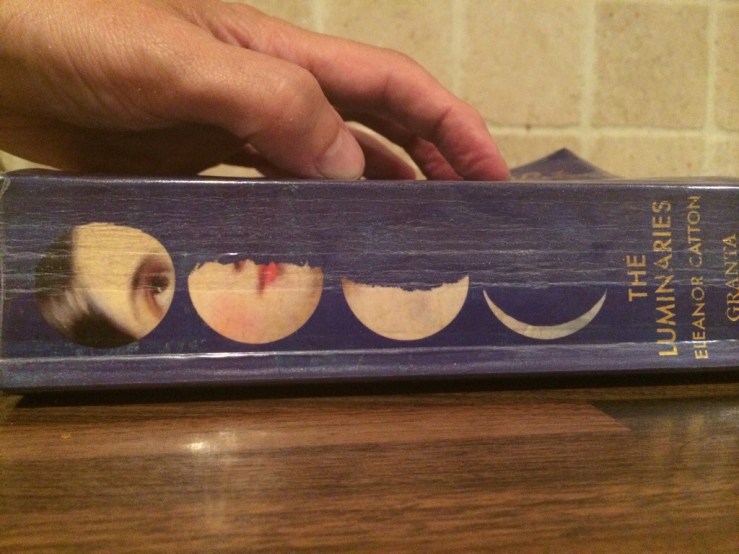Ahhh, Eleanor Catton’s Man Booker winning The Luminaries. It’s certainly not a quick read!
It took such a time to read it – and admittedly my reading coincided with a stroppy baby and a hectic few weeks at work – that the beautiful cover started to wear off! The M of LUMINARIES on the front cover is being rubbed away by my finger as I hold it like this

It was at such risk of becoming dilapidated that I asked the librarian at work to cover it for me!
My 11 month old daughter also loved this book. Not so much the words (she prefers Ten Little Fingers for that!) but the pages being flicked through. In fact, she liked it so much that she’d make a beeline for it as soon as she saw it. Pages became torn as a result.
But I adored this book. I loved Harvest, The Testament Of Maryand A Tale For The Tome Being and I wondered whether this would hold its own and live up to the hype as Man Booker winner. And it did. In spades.
I am a simple fellow and I am sure much of this book swept past me. I am, after all, looking for very few things in a book: a cracking plot; compelling characters; and beautiful language. In addition to all that, there is an effort to create astronomical and astrological connections between the characters.
 I am sure that much of this passed me by!
I am sure that much of this passed me by!
The story centres around one evening in January 14th 1866 when Crosbie Wells, a reclusive hermit, dies near to the New Zealand gold rush town of Hokitika; Lauderback, a politician, arrives in Hokitika and discovers both Wells’ body in his cottage and the unconscious body of Anna Wetherell, a whore, insensate in the streets through an opium overdose; and a famously rich man, Emery Staines, disappears from the same town.
Around this cluster of events, twelve men recognise their own and each other’s involvement. Each man circles this single evening whilst circling the other men as well. Orbiting is clearly an apt word to describe the way each character (and they are all men) become closer to one part of the events of 14th January and more distant from others. That much, I could recognise and – as I said – I’m sure the way each man influences the others around him probably bears some astrological significance. But one I’m ill equipped to identify.
In terms of style, this book piles narrative upon narrative, again orbiting that one night and never quite revealing the truth until the final pages. There is a very much self-aware third person narrator here who, in the opening chapters, is reminiscent of the nineteenth century self conscious narrators. This narrator initially takes the side of Walter Moody, a newcomer to Hokitika who stumbles into a conference held by the twelve men associated with the 14th January events. It is to him that each character tells their tale of involvement. And each of those tales is knitted together for us by the narrator. Circles Within Circles is an incredibly apt name for this part of the book. Courtrooms reinvent one narrative into a quite different story. Flashbacks in the final chapters cause you to re-evaluate and re-think almost all that’s gone before.
The two main characters – Emery Staines, Anna Wetherell are marginalised throughout most of this book! Staines disappeared before the book began; and Anna is sequestered away for large parts of it. They are, however, brought centre stage in the final sections, and it is their voices which resound deepest. I am assuming that this pair of (star-crossed?) lovers are the luminaries, the light givers, of the title, the solar and lunar lights in the sky. I do await to be corrected, however.
It is impossible to pigeonhole this book into a genre: there are elements of Romance between Staines and Anna, elements of Crime around the investigation into Wells’ death, gold thefts, fraud and embezzlement; elements of the Gothic aboard an ill-fated sea journey; elements of the mystical in the relationship between Anna and Staines as bullets that should have struck one inexplicably wound the other, addictions suffered by one and the other’s ability to read and write and sign a signature likewise transferred. It is, however, simply a beautiful book! The vivid quality of Hokitika brought to life with these men orbiting the town and passing by each other; the structural complexity and aesthetic beauty of the book; and the enchanting beauty of a language which feels simultaneously natural and authentically reproducing the prose of another time and place.
After six weeks and 850 pages, I have finished the book with a strong sense of loss and a surprisingly strong urge to re-read it so that the opening chapters can be read in light if what I now know.
That urge to re-read is jolly unusual and a clear mark of just how compelling this book is.
A deserving Man Booker winner to stand alongside Hilary Mantel’s Cromwell books.




With every review I read, I move closer toward the edge ….. ‘Do I buy it or not? Yes? No? In the cart. Out of the cart.’ Safe to say your review pushed me over, and now anticipation builds! Thank you.
LikeLike
[…] only came upon this book and Catton because of her Booker-winning The Luminaries which was also wonderful. But for me The Rehearsal was sublime. It was coruscating and complex and […]
LikeLike
[…] has, nevertheless furnished me with some of my most memorable reads recently: Eleanor Catton’s The Luminaries, which led me to her wonderful The Rehearsal, Ruth Ozeki’s A Tale For The Time Being, How To […]
LikeLike
[…] has, nevertheless furnished me with some of my most memorable reads recently: Eleanor Catton’s The Luminaries, which led me to her wonderful The Rehearsal, Ruth Ozeki’s A Tale For The Time Being, How To […]
LikeLike
[…] offer up are either The Rehearsal, the debut novel by Eleanor Catton who won the Man Booker with The Luminaries, and Neil Gaiman’s American Gods, both of which I have read and listened to as […]
LikeLike
[…] off-piste a little – a little!? – the Booker winning The Luminaries opens each part with a starmap of which three are above. This was a book I loved with a passion, as […]
LikeLike
[…] to Netflix: I’m not sure I have the experience of Netflix to differentiate!): Normal People, The Luminaries, A Suitable Boy, Good Omens, The Witcher and of course A Game of Thrones […]
LikeLike
[…] The Luminaries, Eleanor Catton […]
LikeLike
[…] loved Catton’s Booker Prize winning The Luminaries – although it was so intelligent I fear most of it went over my head with all the astrology. […]
LikeLike
[…] Catton came onto my radar with the Booker Prize winning The Luminaries, a book that had an intellectual and a physical heft to it: it was a massive beast of a book […]
LikeLike